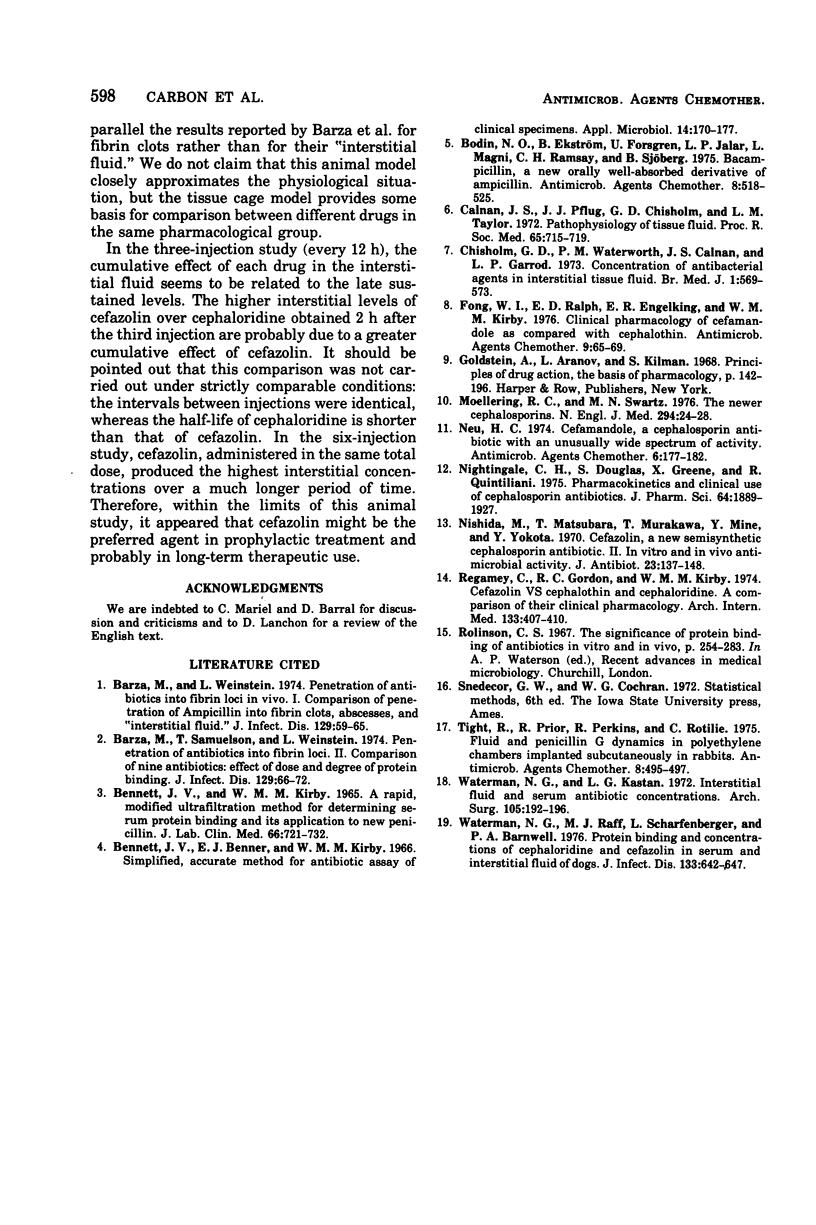Abstract
We compared the penetration of three cephalosporins into interstitial fluid. Interstitial fluid was obtained in rabbits from Silastic tissue cages. Cefazolin, cephaloridine, and cefamandole were administered by the intramuscular route (30 mg/kg per injection). Peak blood levels and interstitial concentrations were studied after a single injection. Interstitial levels were also compared in a three-injection study (one injection every 12 h) and in a cumulative effect study (six injections), in which the interval between injections was established for each drug on the basis of its common therapeutic use. After a single injection, cephaloridine activity was detected more rapidly and attained higher levels than the other two drugs within the first 4 h. However, 2 h after the third injection, cefazolin levels in tissue fluid were higher than with cephaloridine. Cefamandole consistently gave the lowest interstitial levels. With all three drugs, detectable concentrations were present in interstitial fluid at a time when no detectable antibiotic was found in serum. In the six-injection study, the interstitial levels obtained with cefazolin were significantly higher than those observed with the other drugs. Our data suggest that cefazolin is a drug of choice due to its high extravascular levels.
Full text
PDF




Selected References
These references are in PubMed. This may not be the complete list of references from this article.
- Barza M., Samuelson T., Weinstein L. Penetration of antibiotics into fibrin loci in vivo. II. Comparison of nine antibiotics: effect of dose and degree of protein binding. J Infect Dis. 1974 Jan;129(1):66–72. doi: 10.1093/infdis/129.1.66. [DOI] [PubMed] [Google Scholar]
- Barza M., Weinstein L. Penetration of antibiotics into fibrin loci in vivo. I. Comparison of penetration of ampicillin into fibrin clots, abscesses, and "interstitial fluid". J Infect Dis. 1974 Jan;129(1):59–65. doi: 10.1093/infdis/129.1.59. [DOI] [PubMed] [Google Scholar]
- Bennett J. V., Brodie J. L., Benner E. J., Kirby W. M. Simplified, accurate method for antibiotic assay of clinical specimens. Appl Microbiol. 1966 Mar;14(2):170–177. doi: 10.1128/am.14.2.170-177.1966. [DOI] [PMC free article] [PubMed] [Google Scholar]
- Bennett J. V., Kirby W. M. A rapid, modified ultrafiltration method for determining serum protein binding and its application to new penicillins. J Lab Clin Med. 1965 Nov;66(5):721–732. [PubMed] [Google Scholar]
- Bodin N. O., Ekström B., Forsgren U., Jalar L. P., Magni L., Ramsay C. H., Sjöberg B. Bacampicillin: a new orally well-absorbed derivative of ampicillin. Antimicrob Agents Chemother. 1975 Nov;8(5):518–525. doi: 10.1128/aac.8.5.518. [DOI] [PMC free article] [PubMed] [Google Scholar]
- Calnan J. S., Pflug J. J., Chisholm G. D., Taylor L. M. Pathophysiology of tissue fluid. Proc R Soc Med. 1972 Aug;65(8):715–719. [PMC free article] [PubMed] [Google Scholar]
- Chisholm G. D., Waterworth P. M., Calnan J. S., Garrod L. P. Concentration of antibacterial agents in interstitial tissue fluid. Br Med J. 1973 Mar 10;1(5853):569–573. doi: 10.1136/bmj.1.5853.569. [DOI] [PMC free article] [PubMed] [Google Scholar]
- Fong I. W., Ralph E. D., Engelking E. R., Kirby W. M. Clinical pharmacology of cefamandole as compared with cephalothin. Antimicrob Agents Chemother. 1976 Jan;9(1):65–69. doi: 10.1128/aac.9.1.65. [DOI] [PMC free article] [PubMed] [Google Scholar]
- Jolad S. D., Wiedhopf R. M., Cole J. R. Tumor-inhibitory agent from Montezuma speciosissima (Malvaceae). J Pharm Sci. 1975 Nov;64(11):1889–1890. doi: 10.1002/jps.2600641134. [DOI] [PubMed] [Google Scholar]
- Moellering R. C., Jr, Swartz M. N. Drug therapy: The newer cephalosporins. N Engl J Med. 1976 Jan 1;294(1):24–28. doi: 10.1056/NEJM197601012940106. [DOI] [PubMed] [Google Scholar]
- Neu H. C. Cefamandole, a cephalosporin antibiotic with an unusually wide spectrum of activity. Antimicrob Agents Chemother. 1974 Aug;6(2):177–182. doi: 10.1128/aac.6.2.177. [DOI] [PMC free article] [PubMed] [Google Scholar]
- Nishida M., Matsubara T., Murakawa T., Mine Y., Yokota Y. Cefazolin, a new semisynthetic cephalosporin antibiotic. II. In vitro and in vivo antimicrobial activity. J Antibiot (Tokyo) 1970 Mar;23(3):137–148. doi: 10.7164/antibiotics.23.137. [DOI] [PubMed] [Google Scholar]
- Regamey C., Gordon R. C., Kirby W. M. Cefazolin vs cephalothin and cephaloridine. A comparison of their clinical pharmacology. Arch Intern Med. 1974 Mar;133(3):407–410. [PubMed] [Google Scholar]
- Tight R. R., Prior R. B., Perkins R. L., Rotilie C. A. Fluid and penicillin G dynamics in polyethylene chambers implanted subcutaneously in rabbits. Antimicrob Agents Chemother. 1975 Oct;8(4):495–497. doi: 10.1128/aac.8.4.495. [DOI] [PMC free article] [PubMed] [Google Scholar]
- Waterman N. G., Kastan L. B. Interstitial fluid and serum antibiotic concentrations. Arch Surg. 1972 Aug;105(2):192–196. doi: 10.1001/archsurg.1972.04180080046008. [DOI] [PubMed] [Google Scholar]
- Waterman N. G., Raff M. J., Scharfenberger L., Barnwell P. A. Protein binding and concentrations of cephaloridine and cefazolin in serum and interstitial fluid of dogs. J Infect Dis. 1976 Jun;133(6):642–647. doi: 10.1093/infdis/133.6.642. [DOI] [PubMed] [Google Scholar]


